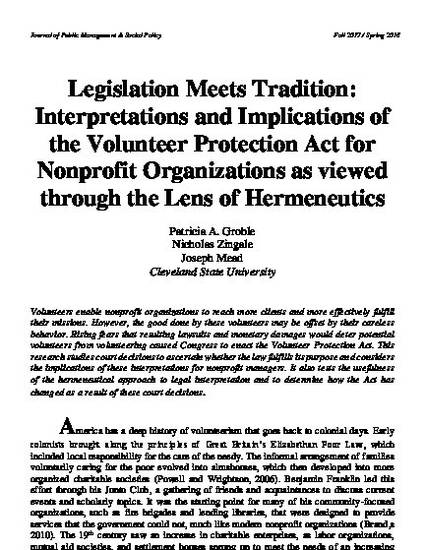
Article
Legislation Meets Tradition: Interpretations and Implications of the Volunteer Protection Act for Nonprofit Organizations as viewed through the Lens of Hermeneutics
Journal of Public Management & Social Policy
Disciplines
Abstract
Volunteers enable nonprofit organizations to reach more clients and more effectively fulfill their missions. However, the good done by these volunteers may be offset by their careless behavior. Rising fears that resulting lawsuits and monetary damages would deter potential volunteers from volunteering caused Congress to enact the Volunteer Protection Act. This research studies court decisions to ascertain whether the law fulfills its purpose and considers the implications of these interpretations for nonprofit managers. It also tests the usefulness of the hermeneutical approach to legal interpretation and to determine how the Act has changed as a result of these court decisions.
Citation Information
Patricia Groble, Nicholas C. Zingale and Joseph Mead. "Legislation Meets Tradition: Interpretations and Implications of the Volunteer Protection Act for Nonprofit Organizations as viewed through the Lens of Hermeneutics" p. Introduction America has a deep history of volunteerism that goes back to colonial days. Early colonists brought with them the principles of Great Britain’s Elizabethan Poor Law, which included local responsibility for the care of the needy. This informal arrangement of voluntarily care for the poor evolved into almshouses, which then developed into more organized charitable societies (Powell & Wrightson, 2006). Benjamin Franklin led this effort through his Junto Club, a gathering of friends and acquaintances to discuss current events and scholarly topics. It was the starting point for many of his community-focused organizations, such as fire brigades and lending libraries, designed to provide services that the government did not, much like modern nonprofit organizations (Brands, 2010). During the 19th century, charitable enterprises such as labor organizations, mutual aid societies, and settlement houses sprang up to meet the needs of an increasing population (Powell & Wrightson, 2006; Ellis & Campbell, 2005). This expansion migrated into government as modern day presidents understood and acted on the need for volunteerism. The second half of the 20th century saw the establishment of such programs as the Peace Corps, Volunteers in Service to America (VISTA) and the Thousand Points of Light Foundation” (Light, 2002; Brudney, 1990). In the 21st century, Congress passed the largest increase in spending in the history of Americorps/National Service programs in the 2009 Serve America Act (Public Law 111-13, April 21, 2009; Nesbit & Brudney, 2010). This history of helping others created a tradition of volunteerism that permeates the fabric of our culture. Four out of five charitable organizations utilize volunteers in some way (Hager & Brudney, 2004). The use of volunteers has been labeled the “third sector” of the American economy (Hartmann, 1989) while redefining, in some ways, governance approaches. The Bureau of Labor Statistics reports that as of September, 2013, over 62.6 million (25.4 %) of Available at: http://works.bepress.com/nicholas_zingale/24/
